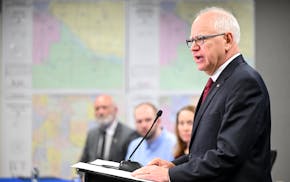DULUTH — The air traffic control tower at Duluth International Airport hails from the 1950s, clocking it as the third-oldest in the country.
About half the size it should be, it's too short for the length of its runways, and necessary repairs or replacements make up a costly laundry list.
The aviation economy in Duluth has grown "exponentially" since the tower was built and makes the biggest financial impact on the state's aviation industry outside of Minneapolis, said Tom Werner, executive director of the Duluth Airport Authority.
"We have a robust and very, very diverse aviation economy here, [which] requires air traffic control to kind of quarterback all that is going on in the air," he said, making it critical to maintain modern technology.
The Airport Authority, backed by the city of Duluth, is asking the state for $14 million to help pay for a $66 million replacement project. The project didn't make the cut during last year's legislative session.
The state money would help snag federal funding to cover the bulk of the project and pay for demolition of blighted buildings to make way for the new tower, environmental work and relocation of an airfield road.
Last fall, Minnesota's entire congressional delegation, led by Democrat Sen. Amy Klobuchar and Republican U.S. Rep. Pete Stauber, sent a letter to the Federal Aviation Administration asking for support for the project. It has a narrow window to procure money from the Infrastructure Improvement and Jobs Act.
"The DLH provides vital service to the region," the letter said, for commercial, cargo and medical service flights, while housing Cirrus Aircraft and the 148th Fighter Wing of the Minnesota Air National Guard. The airport is "crucial to our economic and national security."
The airport serves Delta, United and Sun Country airlines, along with a local helicopter business and Lake Superior College's aviation program. Cirrus tests planes in Duluth, and international flights often stop at Monaco Air to clear customs and refuel.
The authority says it supports over 6,000 jobs and contributes roughly $760 million annually to the economy.
"It really does touch the region as a whole, not just Duluth," said Natalie Baker, a spokeswoman for the Airport Authority.
The tower houses two different services, one for the Duluth airport and its surrounding airspace and one for airspace in much of northern Minnesota. The Terminal Radar Approach Control (TRACON) facility inside the tower extends service up to International Falls and guides aircraft to Range Regional Airport in Hibbing. TRACON saw a 22% increase in operations from 2022 to 2023. Air traffic control for Duluth handled 12% more departures and arrivals in that same time frame.
The 70-year-old tower does not meet current FAA design standards for line of sight, height and size. It leaks, and it needs new heating, cooling and ventilation systems, along with upgraded communication equipment.
Duluth and other greater Minnesota airports were recently awarded federal airport improvement grants. Duluth hasn't yet decided how it will use its $1.7 million, but it received a similar amount last year and put it toward a hangar construction project — the first new hangars the airport has built in more than 20 years. In St. Cloud, its $1 million will also go toward an ongoing hangar project for private aircraft. Rochester's $1.8 million will go toward replacement of an aviation ramp.
Staff writers Trey Mewes and Jenny Berg contributed to this story.
Edina makes badminton history of its own with repeat state title

Three area girls basketball stars trying out for national U-17 team

Heather Edelson wins District 6 seat on Hennepin County Board in special election

Wildfire flares west of Tofte in Superior National Forest

